Conference highlights: Service Design in Government 2019
I was really pleased to have the opportunity to attend SDinGOV once again, and have pulled together a few thoughts and resources from the sessions that stood out the most for me.
The conference was held at the University’s John MacIntyre Conference Centre on Dalkeith Road, so a really convenient event for people in Edinburgh. It’s a super-friendly community event; very similar feel to the higher education web managers conference IWMW in terms of the contributions, openness and collegiate atmosphere.

Service Design for Health and Wellbeing was a commonly represented theme at this year’s conference
Once again, I bumped into Lesley Middlemass from Communications and Marketing’s digital team, and also caught up with Kat Husbands from Glasgow University, so I wasn’t a lone voice from the university sector. It was great to be able to reflect together on how case studies of better government services, access to health services and improving community services have relevance to our work in the higher education sector.
I’m going to pick on some sessions that really stood out for me over the three days. That’s no mean feat as the standard was incredibly high; I was often struggling to decide which of the four available tracks to follow in the conference programme.
The organisers have added slide decks to the conference website, plus many delegates were tweeting slides and opinions throughout.
Conference programme from the SDinGOV website
Twitter feed for the hastag #SDinGOv
Conference highlights
I’m cheating a bit by pulling together multiple talks and workshops under three themes. I wasn’t especially mindful of going into the conference with a focus or an agenda, but now on reflection there are some distinct patterns in what I chose to participate in.
The three highlights I want to share are:
- The Keynotes
- The impact of service design on health and wellbeing
- User research curation and debt
(There was actually another highlight – meeting the Edinburgh students who volunteered to support the conference – but I’ve talked about this already. See: Edinburgh students – service designers of the future)
The keynotes
All three keynote speakers surprised and stimulated me in different ways. Looking at the programme in advance, I wasn’t especially drawn to any of the keynote topics (relative to other parts of the programme) but found all three to be rewarding in different ways.
Matt Edgar, Head of Design at NHS Digital, told the story of the team and the service that was being built within the NHS. The philosophy and the building blocks being established are so important given the scale and the importance of the task.
Working with citizens to deliver new and better digital services is fundamental. This was a theme that came up again and again, and is also a cornerstone of the Scottish Government’s approach to service design.
This is not a service issue, or a digital or IT issue. It’s a cultural issue. And that, I feel is a significant lesson for us as a University.
I really liked this simply expressed diagram. Imagine we swapped out “clinical” for “educational”. (I’m an ex-maths teacher, I love a Venn diagram). A good model for taught student needs, I’d suggest. Yet at the moment we compartmentalise our approaches to understanding student needs and as such don’t conceptualise or deliver holistic solutions.
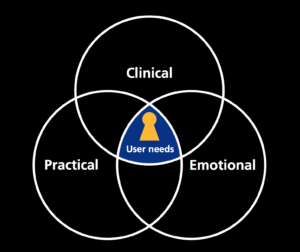
Matt talked about how the NHS needed to better understand and design for the full range of use needs. I think the same is true in universities.
Matt Edgar’s keynote details and slides – Service design for the NHS: the open door
Matt also had the quote of the conference:
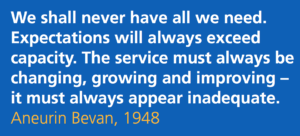
The quote of the conference, without doubt
“We shall never have all we need. Expectations will always exceed capacity. There service must always be changing, growing and improving – it must always appear inadequate.”
Aneurin Bevan, 1948.
That awareness from founding father of the NHS, Nye Bevan, over 70 years ago is remarkably astute. It speaks very much to the here and now. You could almost expect these words to come from someone like Jeff Gothelf who advocates a lean, continuous improvement approach.
Cormac Russell, an advocate of community-based design was the keynote on day 2. I’ll confess that from the synopsis I didn’t have high expectations from this keynote, but Cormac was a very engaging speaker with a perspective that really provoked me. He was the speaker of the conference that I sought out after the event to listen to more of his presentations.
Cormac introduced the concept of Asset-Based Community Development. He asked how can we help people to live a good life. Instead of trying to right what’s wrong within a community Cormac argued we need to start with what’s strong. We need to help people discover what gifts they have and to use those gifts to enrich those around them.
I don’t think a paragraph or two here would do his talk justice, so I’d recommend you explore for yourself. His TEDx talk is a short(ish) introduction.
Sustainable community development: from what’s wrong to what’s strong – Cormac Russell talks at TEDxExeter – 18 minute presentation on YouTube
Cormac Russell’s keynote synopsis and slides at the conference
Ade Adewunmi, a data transformation consultant, was day 3’s keynote.
She started with probably my favourite slide of the whole conference.
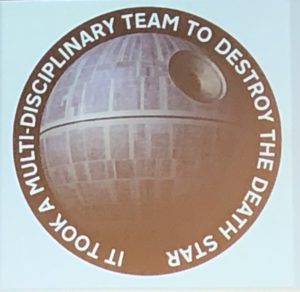
My favourite slide of the conference, in a really entertaining and thought-provoking keynote on data and trust
Ade’s talk concerned data and trust. While service design is at the heart of much transformational activity in many public sector organisations, we have to recognise that data is driving the transformation and she talked about the potential benefits from data driven innovation from both the perspective of the service designer and also for the citizen.
One of Ade’s most pertinent points for me was when she challenged a (sort of) famous quote from a GDS blog post.
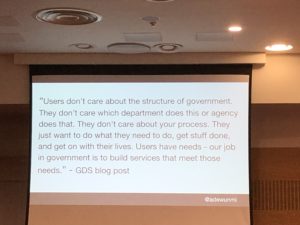
Ade Adewunmi asked whether this statement is really true. Perhaps if you’re on the happy path and everything goes smoothly. But what if you need redress or are in a vulnerable position?
The slide reads: “Users don’t care about the structure of government. They don’t care which department does this or agency does that. They don’t care about your process. They just want to do what they need to do, get stuff done, and get on with their lives. Users have needs – our job in government is to build services that meet those needs.” – GDS blog post.
I confess I’ve said similar myself when working with business units across the University who were trying to put their organisational stamp or “brand” on their service.
But Ade asked whether this statement is really true. Perhaps if you’re on the happy path and everything goes smoothly.
But what if you need redress or are in a vulnerable position. Then, perhaps knowing precisely who you’re dealing with and how they’re going to treat your sensitive data starts to become very important.
This point really resonated with me, particularly as I get more involved in the experiences of current students, and helping the University establish how to better support them when things aren’t going right. Particularly in times of stress and with issues around mental wellbeing.
The impact of service design on health and wellbeing
And this leads me on to the second highlight. Whether intentionally or not, I was drawn to a number of sessions delivered by people working in health-related areas. Looking across the whole programme now, there was actually a strong presence from this part of the public sector, so possibly my pulling out of this trend was inevitable.
But I was particularly inspired by a couple of case studies which were great examples of how taking a new approach to design, ensuring multidisciplinary involvement, and keeping subject matter experts at the centre could have real impact.
In particular, listening to Service Designer Martyn Evans and Physiotherapist Mel Martin’s talk: Creating a minimum viable NHS service really excited me as I could see the potential of such an approach at the University. Here, they talked about the roles they played in the redesign of patient services at the Rheumatology Department of Guy’s and St Thomas’ NHS Foundation Trust had impacted the lives of a wide range of people affected by rheumatoid arthritis.
Mel talked about how she’d come to be the product owner for the service, how learning about service design and agile development had influenced her thinking and most importantly how these new approaches were helping her and her medical colleagues to deliver demonstrably better services to patients and make better use of the resources they had available to them.
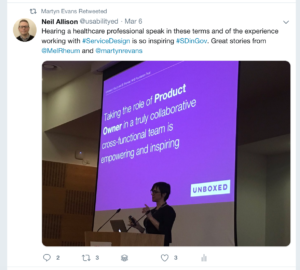
It was inspiring to hear a medical professional speak so enthusiastically about really engaging with the design process to deliver improved patient outcomes.
Synopsis and slides for: Creating a minimum viable NHS service
The other health-related case study I really enjoyed was from service designer Helen Spires and content designer Lindsay Green: Joining the dots – designing for free prescriptions from the NHS in which they recounted the complexities of the prescription service across regions of the UK that resulted in many people being fined for incorrectly claiming free medicine, while others paid when they didn’t have to.
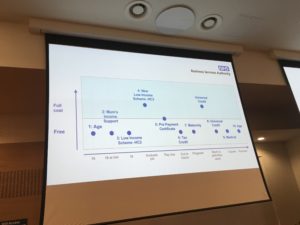
This graph illustrated well how confusing it can be to establish when and why you’re entitled to free prescriptions.
Why is it so complex? Policy lasagne. A great term coined by the speakers to express the impact of layers of amendments being added over the years to legislation set out in 1968. I particularly liked the example they quoted of how coal counts towards your income. Coming from a coal mining town in County Durham, I knew exactly what they were talking about but I expect the majority of the room were as bemused as they’d planned.
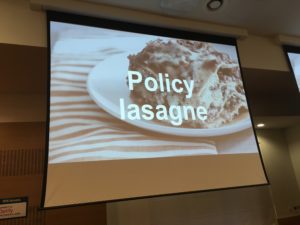
The speakers introduced ‘Policy Lasagna’, where years of amendments to legislation are layered on top, making it incredibly (and unnecessarily) complex.
This story was much bigger and more complex than the one at the Rheumatology Department. While there perhaps weren’t the big impacts that are possible at a smaller scale with a product owner steering priorities, the smaller but further-reaching impacts here were just as inspiring. And the impact that quality copy can have on a service was coming out loud and clear. This was really pleasing and one to share more widely within the University where I continue to fight for the recognition the great content designers in our team deserve.
Synopsis for: Joining the dots: designing for free prescriptions from the NHS
Research appraisal, curation and debt
The final theme in my highlights is something that’s very dear to my heart at the moment. After a productive couple of years establishing the University’s UX Service and overseeing research and design activity in a broad range of areas, we are becoming victims of our success to some degree.
Keeping on top of all the insight we’ve generated, ensuring it’s curated effectively as the people who undertook the work move on, and being able to return to it when colleagues come to us with new (but related) challenges is a difficult task.
(Sort of) reassuringly, others are also grappling with this issue. It’s something that’s been bubbling under for me for quite a while now, but we have had to focus our energies on proving the value of the Service to the University. We’ve prioritised working for others over our own service housekeeping.
Thankfully we have a bit of breathing space coming up which will enable us to get our house in order, so the sessions I attended in this area were really timely.
Caroline Jarrett and Stephanie Rosenbaum ran a workshop on how to avoid research debt which was excellent, both for the openness and insight supplied by the excellent facilitators and for the candidness and sharing of the people around my table.
Research debt session slides on Slideshare
(Caroline tells me a blog post on the output of the workshop is in the pipeline. I’ll update here when I have it.)
Lucy Stewart and Mather Trivett shared a case study: Building a user research library for local government which was really inspiring. We’re essentially doing this in house using Sharepoint and no dedicated project time, so we have much to learn from the endeavours of service design agency Snook and their partners at Hackney Council.
Synopsis and slides for building a user research library
Finally, a group from the Government Digital Service presented a case study: Creating safe spaces for challenge – being a lead assessor for Government Service Standard assessments which emphasised to me just how much time and effort is going into setting standards for digital service design in the UK government. They were candid about what was challenging and it really brought home to me how much effort, resource and most importantly, trust and honesty are needed to ensure standards of delivery. We’re just starting our journey with standards to try and ensure a higher level of quality in digital service provision, and we have a long way to go.
Synopsis and slides for Creating safe spaces for challenge
In conclusion…
Once again, the Service Design in Government conference was an inspiring, welcoming and thoroughly enjoyable conference.
We are so lucky in Edinburgh to have this happening here.
I’m hoping that the impact our UX Service is having on projects and services within the University will inspire more colleagues to engage next year. The importance of service design to the future health of our institution cannot be understated, in my opinion.
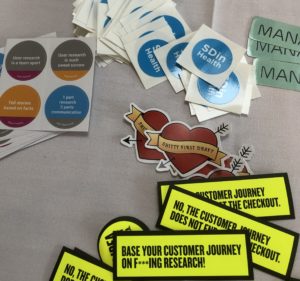
Some of the stickers and paraphernalia being shared at the conference

